|
List of Essays
Essay by Artist
Contemporary Artists, Fourth Edition (click here to read)
Essay by Szymon Bojko
Art Cirtic
Contemporary Artists, Fourth Edition (click here to read)
Essay by Elena Millie
Curator, Library of Congress
Contemporary Artists, Third Edition (click here to read)
Essay by James Beck
Professor of History of Art, Columbia University
Contemporary Designers, Third Edition (click here to read)
Fantasm and Fiction: On textual Envisioning
by Peter Schwenger
University of Stanford Press, 1999 (click here to read)
Essay by Kara Rooney
Art Cirtic
Catalog for Reflections on Everyman: The Work of Jan Sawka, an exhibition curated by Evonne M. Davis and Hanna Maria Sawka, Sept. 12 - Dec. 14, 2013, Gallery Aferro, Newark, NJ (click here to read)
Essay by Krzysztof Miklaszewski
"The Birth of an Artist, or the Beginning of Jan Sawka's Creative Path, 2021."
Link to the original article in Polish (pdf)..
Link to translation of article by Hanna Maria Sawka (with assistance of Deep L translator).
|
|
|
Contemporary
Artists
Fourth Edition
St. James Press, New York, 1995
By Jan Sawka
I'm sure I know why and what I
paint. It's something like a feeling of warmness in your head;
a half-ready answer is waiting. But when I must put it down, my
God, it's not so easy.
From the very beginning, from
childhood, something was wrong with me (oversensitivity, the family
physician stated). Books and reading interested me first. As far
as I can remember drawing was somehow regarded as natural, not
respected at all -- like eating or playing with toys. My parents'
house was overwhelmed by books and discussions during those dark,
Stalin years. Little groups of friends gathered over the bridge
table, not so much to play but mostly to talk.
Up to the last moment before
entering higher education, I was unsure what to choose -- philology
at the university of fine arts at the academy. But the "oldies"
decided to push me toward some "practical" career -- architecture,
engineering. And that was the beginning of my way to the
current painting. Nothing fitted me properly, the frustrations
built up; now I understand it was very positive this manytimes-forced
way.
Disillusioned by technical training
in architecture, I began desperately to add something more to
this boring existence. The relatively lively cultural life of
city students lured me quickly. Jazz, "nightlife," cabarets, theater
-- I lived for it, waiting nervously every day at the drawing
rooms of school. Troubles built; I hardly managed to pass all
the exams. Finally, after two years, without resigning from my
engineering school, I joined the Fine Arts Academy, trying to
cope with two problems. But my "off-duty" activity didn't cease;
it grew. Although extremely hectic, it was a far more exciting
life. The next event, which shaped my entire life, was not designed
by me but by the "Reds." Nineteen sixty-eight; student riots,
Zionists, Revolutionists, tanks rumbling down Prague streets.
It was a time of extreme tensions and simple "yes" or "no."
After the amnesty was granted
by the government to all (almost all) unruly students, I tried
to rebuild. But amnesty was mainly on paper. Practically, I was
eliminated. However, some brave people fought back, and by 1969
I had carefully constructed, multi-media study program, which
protected me from being pushed out of the schools but gave me
a mad schedule. Staying at the architecture faculty, I studied
mostly design, while I worked also at the history of art institute
as a junior researcher in my free time, restoring churches, etc.
To keep "them" happy, I worked around the clock.
My "post-school" activities had
grown serious. By the early 1970s, I was among those who had rejected
the "Socialist way" and tried to pursue "free culture" (read:
"counter-Red establishment"). My real companions were theater,
poetry, cabaret, the visual arts -- and I did anything that was
needed. Thank God, it paid well, not in money but in far more
important bonuses: I traveled abroad, all over Western Europe.
You don't understand how hungry somebody can be to see the normal,
civilized life of the Western world. During this time, I worked
on those hard-to-formulate, private tensions -- my private world.
Now, how do I say what
I paint? Maybe it sounds megalomanical, but I try to discuss the
world I see and feel. I try to care about the composition, shape,
color, the so-called "form," of course. I try to execute paintings
in the best possible way -- no easy tricks, no airbrushes, no
copying from slides -- all hand, pure hand.
But, most importantly, I try
to communicate with all, concerned and unconcerned. I have no
idea which trend of art I represent. Nothing interests me less.
Of course, I'm sensitive to many currents of modern art, but I
try to understand art as a whole. I love Old Masters but try to
put their work into a larger context, not to separate their canvases
from literature, music, society. I listen to music during my work.
I read. I try to know a little of everything. They did the same,
I think. You cannot close yourself in a personal shell. Or maybe
you can. I can't. (Adapted from an interview published in Arts
Magazine (New York), May 1983.)
Since my last entry in the publication,
in 1990, dramatic changes occurred in my life and work. Once a
leading artist of the Polish Poster school, today I do very little
graphic design. In the 1980s I established myself in the galleries
of New York City as a painter and printmaker. The 1990s further
reinforced my position as an installation artist, only sporadically
active as a graphic designer. Starting in 1990 I have had a series
of museum shows of my works all over the world.
I started to develop two new
and important new venues in my work: sculpture and multimedia
experiments. It all started with the 1989
concert sets for the Grateful Dead. From there I went to the
new hand highly experimental projects. The art created directly
by me, on canvas or paper, is being transformed to the kinetic
images projected on screens or directly on the walls by computer
synchronized projectors supported by light and original pieces
of art. I designed the series of concepts for such theatrical
or music pieces with the entire "visual space" created by me.
The concept for Handel's Messiah
was followed by my production of the Visual Theater spectacle
at the Art Tower Mito, in Mito, Japan, in 1993. It was the first
time I collaborated with California-based projections and light
designer Marc I. Rosenthal, with whom I am working on almost all
new projects of such nature. After the first successful production
I designed projection-based concert sets for Steve
Winwood and Traffic in 1994.
Later that year I went to Tokyo
to concentrate on the development of sculptures, multimedia works,
and projects for architecture. I was awarded a special grant by
the Japanese Cultural Agency to stay in Tokyo and experiment.
The results were fantastic! I was teamed with the best architects,
designers, and electronic engineers Japan has today. The series
of large sculptures emerged in concepts which will soon be realized,
but the most important project born in Tokyo was the Tower
of Light. The giant monument as well as the live screen for
kinetic images was prepared for presentation to the ruler of the
United Arab Emirates. In designing and preparing the proposal
for the tower I got formidable help from leading Japanese corporations
like Sumitomo and Nippon Glass besides the architectural offices
and planners.
Sometimes I must pinch myself
when flying to Tokyo or Abu Dhabi again... It feels like a magic
trip for an artist who began his career as an underground graphic
artist in Krakow, Poland. Years ago, when my father was pushing
me to study architecture before turning to painting, I hated him.
But he insisted, saying: "The true artists must know architecture
-- it could come in handy one day, you never know." God bless
my father.
To put it the simplest way, I
see design, architecture, and art as one potent mixture of ideas,
rules, and challenges. Not only to create new space and color
and images for people, but also to use this magic mix to work
with the musicians, actors, writers, dancers, and all creative
types on building THE CULTURE, regardless of religions, borders,
systems...
|

Contemporary Artists
Fourth
Edition
St. James Press, New York, 1995
Szymon Bojko
For the reader who wants to be
acquainted with Jan Sawka's early work (1970-1990), I greatly
recommend Elena Millie entry in Contemporary
Designers (St. James Press, 1990), which focuses on the artist's
graphic design production and his paintings. "Perhaps,"
Millie states, "Jan Sawka is a visionary of our time."
This was written long before the important reorientation and change
-- which confirmed Millie's judgement -- had occurred in the artist's
approach to his work.
The 49-year-old maverick American
of Polish extraction with Slavic temperament and wit works now
hand in hand with electronic and high-tech tools, enriching his
material with visions originating in his childhood.
Trained in architecture, based
in rationalism, experienced in painting and printmaking, exploring
old masters' engraving techniques and drawing, skilled in book
illustration and poster design, collaborating with illustrious
poets and playwrights, author of "artists books" and
"postcards," scenic design, illustrations, sculpture,
a craftsman, believing in the power of a pencil, brush, eye, and
hand, Sawka is more than any one else in the contemporary art
world fully conscious of the new dimensions and scale of the coming
era of communication.
In the 1990's Sawka, who lives
in the country outside of the great art centers and works in a
barn, started down a new path. One could call it an "acceleration
in rhythm and in the tempo of being." From and artist who
performed quite successfully in distinguished New York galleries
and museums, and other indoor sites, he started to bring his ideas
and dreamlike visions to macro space, to the modern agora where
thousands of people gather in order to participate. It's there,
like in ancient times, where young and old, rich and poor, can
enjoy the mystery of music, word, and spirituality.
The "ego" and subjectivity
of an artist can no longer be maintained -- it is divided, transformed
by a team of equal creators: producers of images, music, technicians
who operate light, sound acoustics; constructors and computer
operators. Isn't it that kind of production that was known in
Greece during the Dionysian or Olympic festivities or later on
at Bacchanalian wine orgies?
Sawka's work appears nowadays
in theaters, rock music festivals, concert halls in the USA as
well as Japan, Spain, Poland, Hungary, with a perspective which
can be extended to the Near East, Italy, Taiwan, and other places
in the world. The artist defines himself as a multi-media man,
which is correct in definition but doesn't indicate the cultural
context of his work. One must recall here Wagner's vision of Gesamkunstwerk,
Baudelaire's ideal of "Correspondence des Arts," Scriabin,
and Kandinsky's modern model of unified art work, where music,
dance, poetry, rhythm and light support spacio-architectural concepts
and vice versa.
In our time such ideas -- revealed
here and there -- oppose the gloomy perspective of a "global
village" uniform, passive, without joy and interaction. Sawka's
recent images derive from his previous iconography -- colorful
and powerful banners float in the air set on open-air platforms:
mysterious large eyes move in obscurity, frightening and evoking
anxiety; pieces of paintings, blown up and synchronized by computer,
bring to the contemporary eye and ear new experience.
Let us quote among other projects
and productions the first gigantic outdoor objects and banners
for The Grateful Dead rock
performances (1989), the British rock group Traffic (1994), "Eyes"
at the Art Tower Mit in Japan, "The Messiah," an audio-visual
project based on the masterpiece by Handel -- images appearing
in the air -- the Vatican version appearing in 1992.
Sawka is currently working on
"The Tower of Light,"
a 100-meter-high obelisk with kinetic art projections to the music
of Summerlin, in Abu Dhabi; and "The
Window of Hope," a 35-meter-high monument to commemorate
the 50th anniversary of the bombing of Nagasaki, Japan.
The dimension, format, and geometrical
range of these multi-media concepts give and idea of Jan's endless
energy and artistic vitality.
|
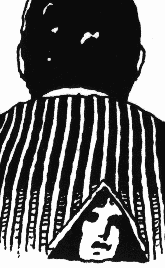
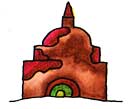

|
|
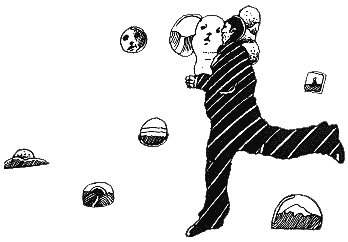
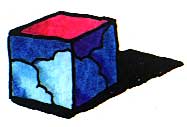
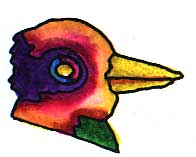


|

Contemporary
Designers
Third Edition
St. James Press, New York, 1997
Elena Millie, Curator,
Library of Congress, Washington
D.C.
Perhaps Jan Sawka is a visionary
of our times. In 1980, he designed a poster titled "Car
of the Year" which won first prize at the Eighth International
Poster Biennale in Warsaw. It pictured a new-style, Russian
tank rolling down a city street. On December 13, of the next year,
tanks did indeed roll in Poland as a show of strength behind the
government-imposed martial law. Sometime before that fateful day,
Sawka had also been requested by the leaders of Solidarnosc, the
powerful Polish union, to design the official
Solidarnosc poster which would express, among other things,
the hopes of the Polish people. The design for the poster showed
the sun of Solidarnosc shining down forever on the hopes and dreams
of a colorful landscape of the Polish people below. The original
artwork was secretly transported into Poland and proudly displayed
in the headquarters of the Solidarnosc until it was destroyed
by the Polish government. The poster, however, could not be suppressed;
nor could Solidarnosc, which contributed to the toppling of the
Communist regime in Poland.
As a student, Sawka had participated
in the political underground, but being a talented and gifted
artist, he was rescued from any serious repercussions. He was
a student of design and the fine arts at the time of his emergence
into the Polish poster movement. Realizing that acceptance into
the Polish poster movement would have to be step-by-step up the
already established ladder, he set out designing posters according
to his own rules, artistic expertise, and available technique.
His first poster was a linoleum cut for a student musical group;
after that, he was asked to design other posters for various music
clubs and student groups. By the time of his diploma show for
graduation, Sawka had thirty posters to exhibit, as well as his
paintings, prints, and drawings.
Later, Sawka moved to Krakow,
which he considered the cultural center of Poland. There he was
asked to be art director for the renowned Polish avant-garde theater,
STU. Although he received no salary, he was given a free hand
to design whatever he chose.
In his student days, he has studied
all aspects of design in order to understand all the processes
and fine art of culture. By understanding the varied aspects of
culture, Sawka believes that he can then better understand the
relationships and complexities of mankind. He attempts to express
this in his work.
As an artist who developed during
the 1960's, Sawka reveals the influence of the psychedelic in
both his compositions and in his use of colors. While his designs
are always -- without exception -- powerful, they are also satirical,
symbolic, humorous, bursting with energy, and imaginatively created.
The colors he uses are combined in an explosive melange. The lasting
and overall effect is one of total honesty. Sawka converses in
his language -- art -- succinctly, truthfully, and creatively.
He does not compromise his iseas or designs for expediency. His
images cause one to confront oneself, to examine one's thinking,
one's way of life, one's hopes and dreams.
A versatile artist, Sawka paints,
draws, and designs what he sees and what he believes in. His graphics
reveal his insights into every phase of life -- culture, politics,
society, history, etc. He considers the poster a personal statement
about the problem or subject. When designing a poster, he uses
the medium he is working on at the time. If he is working on a
print, the poster will look like a print; if a painting, the poster
will look like a painting. Having studied architecture, his work
naturally includes many architectural elements. He displays talent
in every medium; etching, engraving, stencil, linocut, drypoint,
etc. From miniatures to wall-sized works, he works on masonite,
paper, plywood, etc., using gouache, crayon, felt-tip, ball point,
and acrylic -- in any combination.
While in the United States, Sawka
has become recognized not only for his expertise as a painter,
but also as an illustrator. He has made more than 200 illustrations
for the op-ed pages of the New York Times and the Boston
Globe. These assignments have helped Sawka to understand
the United States. Before he could execute the commission, he
had to understand the current political or social situation he
was to interpret. He has a knack for reducing each complex assignment
to its simplest common denominator. His social comments on "the
system" are artfully and delightfully drawn.
Freedom, as one can imagine, is
very important to this designer, and he has expressed this though
his graphics. His designs warrant more than one look, for although
the exuberance is apparent, the real meaning, which is often biting,
is sometimes concealed, often in narratives in the form of the
comic strip, revealing the message which has been interwoven through
the design.
Sawka's first major international
award was won in 1975 in Cagnes-sur-Mer for a painting. The painting
consisted of 216 smaller paintings that gave the illusion of being
prints and drawings. In New York City in the 1980's, he again
turned his creativity to painting. Sawka's achievements and zest
serve as an inspiration to other young designers throughout the
world. As Sawka himself has said oh his life so far in this country:
"I am successful, I do what I want, I shall stay my old self,
I, Jan Sawka."
|

Contemporary
Designers
Third Edition
St. James Press, New York, 1997
Professor James Beck, History of Art,
Columbia University
The exhibition by Jan Sawka in
the Queens Museum of Art offers a total panorama of the artist's
long-range objectives. Standing as a telling event on the basis
of the depth of his artistic invention, it documents his emergence
as a painter of pictures from the time he arrived in America in
1979. After all, given the restriction under the totalitarian
governments in his native Poland in the recent past, fine artists
were never at liberty to take one or another medium merely out
of desire, gift, or interest. Sawka, who was oriented toward the
creation of posters, graphics, and stage design, carved out a
predominant position at a very young age. Still, he was not free
to paint, despite his yearnings to work with the brush and with
tubes of color. So when he came to America, leaving restrictions
behind he was finally able to explore the potential of pure painting
to it's fullest extent. Thus as he moved from images that are
more or less dependent upon his graphic habits to a more painterly
statement -- where he could more naturally from one extreme to
another -- we are permitted to follow his process toward pictorial
independence.
To designate Sawka as a complex
man and a complex creator is an understatement. Yet, approaching
his pictures requires forays into both aspects, that is to say
the artist and the man, although the two are of course inseparable.
At the very core of one aspect
of his essence is an intense connection, affection, passion, and
high hopes for his Poland, which has endured, despite more than
its share of crash landings. Occupation at that hands of two cruel
invaders was coupled with economic calamities. Behind all these
hardships stands the strength of a people and its tradition which
is also Sawka's strength. What I am trying to say, even if it
sounds incurably romantic and from another historical moment,
is that Jan Sawka is a patriot. His Poland is not its armies or
national ambitions for new borders but a land of struggling intellectuals,
poets, writers, dramatists, composers, and fellow fine artists,
all on or close to the financial edge but creatively churning.
Although essentially he has ben absent from Europe for a long
time, by commitment and personality, by temparament and vision,
Jan has retained a close bond with the uncompromising artistic
spirits back home.
His aspirations for Poland's
future are in step with his concerns for the neighboring countries
once again locked within a historical vise between Germany and
Russia. Jan retains a curious and unrivaled intermingling of cosmopolitan
realpolitik and a land-based wholesomeness. A large dose of fantasy
combined with a healthy, inherent optimism conditions his thinking
towards basic human conditions. Memory may be mixed with desire
but it takes place within a claustrophobic interior room or within
the confines of a phone booth: obituaries fade away into shadows
of recollections of the pavement.
The point is that Jan Sawka is
a very smart fellow. His lively thoughts accelerate like a Ferrari
Testa Rossa on the Utah Salt Flats, there being very little affecting
our modern society that he does not ponder. He is an avid reader
on all subjects, from biographies of world class automobile moguls
to avant garde theater. Jan has a flair for rigorous analysis
of current trends, political in-fighting, papal strategies vis-a-vis
the Ukraine, artistic maneuverings of the establishment toward
Arte Povera, and even the latest video from the Grateful Dead.
Another side of Jan Sawka thinks
in images, in segments and snippets, jagged Tuscan horizons and
green fields in the New York Catskills. That is, the painter slides
through his world of printmaking, for he has never stopped etching
and he is still a master of the poster: in these mediums his visions
are elaborate and even grandiose. Eve in his most ambitious projects
-- filling a stadium full of his banners or lighting a vast, columned
piazza with an unprecedented performance of light and color imaginings
-- the artist and the social individual coalesce.
It is a relatively easy matter
for a critic to describe his paintings, since the are quite suitable
to narrative explication, being graphic, clear, blunt statements
in a modern context. More difficult is pinning down the synthesis
between the individual and the artist, each aspect reinforcing
the other. The Queens exhibition is the most manifestation of
Sawka's passionate pictures executed in America. To further complicate
the equation, however, he is very much an American too, operating
in the distinguished tradition that has offered constantly renewed
strength to the United States as a nation and to its newly arrived
as well. His American experience, which is the final factor in
the process of cross-stimulations that have given rise to a unique
statement. (Adopted from Jan Sawka in Queens" in the exhibition
catalogue Jan Sawka Mixed Media Paintings by James Beck.)
|
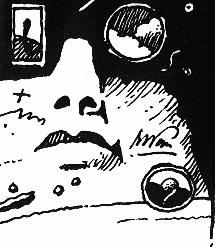
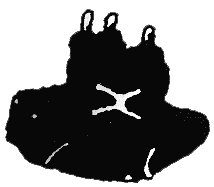
|

Contemporary
Designers
Third Edition
St. James Press, New York, 1997
Professor James Beck, History of Art,
Columbia University
The exhibition by Jan Sawka in
the Queens Museum of Art offers a total panorama of the artist's
long-range objectives. Standing as a telling event on the basis
of the depth of his artistic invention, it documents his emergence
as a painter of pictures from the time he arrived in America in
1979. After all, given the restriction under the totalitarian
governments in his native Poland in the recent past, fine artists
were never at liberty to take one or another medium merely out
of desire, gift, or interest. Sawka, who was oriented toward the
creation of posters, graphics, and stage design, carved out a
predominant position at a very young age. Still, he was not free
to paint, despite his yearnings to work with the brush and with
tubes of color. So when he came to America, leaving restrictions
behind he was finally able to explore the potential of pure painting
to it's fullest extent. Thus as he moved from images that are
more or less dependent upon his graphic habits to a more painterly
statement -- where he could more naturally from one extreme to
another -- we are permitted to follow his process toward pictorial
independence.
To designate Sawka as a complex
man and a complex creator is an understatement. Yet, approaching
his pictures requires forays into both aspects, that is to say
the artist and the man, although the two are of course inseparable.
At the very core of one aspect
of his essence is an intense connection, affection, passion, and
high hopes for his Poland, which has endured, despite more than
its share of crash landings. Occupation at that hands of two cruel
invaders was coupled with economic calamities. Behind all these
hardships stands the strength of a people and its tradition which
is also Sawka's strength. What I am trying to say, even if it
sounds incurably romantic and from another historical moment,
is that Jan Sawka is a patriot. His Poland is not its armies or
national ambitions for new borders but a land of struggling intellectuals,
poets, writers, dramatists, composers, and fellow fine artists,
all on or close to the financial edge but creatively churning.
Although essentially he has ben absent from Europe for a long
time, by commitment and personality, by temparament and vision,
Jan has retained a close bond with the uncompromising artistic
spirits back home.
His aspirations for Poland's
future are in step with his concerns for the neighboring countries
once again locked within a historical vise between Germany and
Russia. Jan retains a curious and unrivaled intermingling of cosmopolitan
realpolitik and a land-based wholesomeness. A large dose of fantasy
combined with a healthy, inherent optimism conditions his thinking
towards basic human conditions. Memory may be mixed with desire
but it takes place within a claustrophobic interior room or within
the confines of a phone booth: obituaries fade away into shadows
of recollections of the pavement.
The point is that Jan Sawka is
a very smart fellow. His lively thoughts accelerate like a Ferrari
Testa Rossa on the Utah Salt Flats, there being very little affecting
our modern society that he does not ponder. He is an avid reader
on all subjects, from biographies of world class automobile moguls
to avant garde theater. Jan has a flair for rigorous analysis
of current trends, political in-fighting, papal strategies vis-a-vis
the Ukraine, artistic maneuverings of the establishment toward
Arte Povera, and even the latest video from the Grateful Dead.
Another side of Jan Sawka thinks
in images, in segments and snippets, jagged Tuscan horizons and
green fields in the New York Catskills. That is, the painter slides
through his world of printmaking, for he has never stopped etching
and he is still a master of the poster: in these mediums his visions
are elaborate and even grandiose. Eve in his most ambitious projects
-- filling a stadium full of his banners or lighting a vast, columned
piazza with an unprecedented performance of light and color imaginings
-- the artist and the social individual coalesce.
It is a relatively easy matter
for a critic to describe his paintings, since the are quite suitable
to narrative explication, being graphic, clear, blunt statements
in a modern context. More difficult is pinning down the synthesis
between the individual and the artist, each aspect reinforcing
the other. The Queens exhibition is the most manifestation of
Sawka's passionate pictures executed in America. To further complicate
the equation, however, he is very much an American too, operating
in the distinguished tradition that has offered constantly renewed
strength to the United States as a nation and to its newly arrived
as well. His American experience, which is the final factor in
the process of cross-stimulations that have given rise to a unique
statement. (Adopted from Jan Sawka in Queens" in the exhibition
catalogue Jan Sawka Mixed Media Paintings by James Beck.)
|


|

|